The Mac
@TheMac
27 May, 07:23
An ideal Fermi gas is a state of matter which is an ensemble of many non-interacting fermions. Fermions are particles that obey Fermi–Dirac statistics, like electrons, protons, and neutrons, and, in general, particles with half-integer spin. These statistics determine the energy distribution of fermions in a Fermi gas in thermal equilibrium, and is characterized by their number density, temperature, and the set of available energy states. The model is named after the Italian physicist Enrico Fermi.
This physical model can be accurately applied to many systems with many fermions. Some key examples are the behaviour of charge carriers in a metal, nucleons in an atomic nucleus, neutrons in a neutron star, and electrons in a white dwarf.
This physical model can be accurately applied to many systems with many fermions. Some key examples are the behaviour of charge carriers in a metal, nucleons in an atomic nucleus, neutrons in a neutron star, and electrons in a white dwarf.
Notice: Undefined index: tg1tga_access in /home/admin/www/anonup.com/themes/default/apps/timeline/post.phtml on line 396
katerina_kat QZ Ventouri
@KaterinaQuark
27 May, 11:45
In response The Mac to his Publication
I would like to ask you, if you want to tell me? in the corona of the sun eclipses are created by the hydrogen of the sun which is approved by the high temperature and they become plasma?
Notice: Undefined index: tg1tga_access in /home/admin/www/anonup.com/themes/default/apps/timeline/post.phtml on line 396
The Mac
@TheMac
27 May, 12:18
In response katerina_kat QZ Ventouri to his Publication
NASA: Physically, the chromosphere begins near the surface of the photosphere with a temperature near 4700 Celsius and a density of 1017 particles/cm3 (2x10-4 kg/m3), and at its highest level reaches a temperature near 25,000 Celsius and a lower density of 1010 particles/cm3 (2x10-11 kg/m3). But rather than being just a homogenous shell of plasma, it resembles the troposphere of our own planet Earth with complex storms and other phenomena roiling its volume from minute to minute.
Notice: Undefined index: tg1tga_access in /home/admin/www/anonup.com/themes/default/apps/timeline/post.phtml on line 396
The Mac
@TheMac
27 May, 12:18
In response The Mac to his Publication
The reason for this is that the magnetic fields formed at or below the surface of the photosphere are not confined to the solar surface, but extend through-out the chromosphere. Magnetic arcs, prominences and other carpets of magnetic activity repeatedly form and dissolve, releasing energy and stirring up the chromospheric plasma. Solar physicists call the chromosphere and the narrow region above it the solar ‘interface region’. It is a complex zone of plasma and magnetic field, which transmits matter and energy between the photosphere and the corona.
Notice: Undefined index: tg1tga_access in /home/admin/www/anonup.com/themes/default/apps/timeline/post.phtml on line 396
The Mac
@TheMac
27 May, 12:19
In response The Mac to his Publication
"magnetic activity repeatedly form and dissolve, releasing energy and stirring up the chromospheric plasma."
Notice: Undefined index: tg1tga_access in /home/admin/www/anonup.com/themes/default/apps/timeline/post.phtml on line 396
The Mac
@TheMac
27 May, 12:20
In response The Mac to his Publication
"with a temperature near 4700 Celsius"
Notice: Undefined index: tg1tga_access in /home/admin/www/anonup.com/themes/default/apps/timeline/post.phtml on line 396
The Mac
@TheMac
27 May, 12:22
In response The Mac to his Publication
At around 80 °C, a magnet will lose its magnetism and it will become demagnetized permanently if exposed to this temperature for a period, or if heated above their Curie temperature. Heat the magnet even more, and it will melt, and eventually vaporize.
Notice: Undefined index: tg1tga_access in /home/admin/www/anonup.com/themes/default/apps/timeline/post.phtml on line 396
The Mac
@TheMac
27 May, 12:24
In response The Mac to his Publication
Note: A dipole is a separation of opposite electrical charges. A dipole is quantified by its dipole moment (μ). A dipole moment is the distance between charges multiplied by the charge. ... The distance separating opposite electrical charges also affects the magnitude of the dipole moment.
Notice: Undefined index: tg1tga_access in /home/admin/www/anonup.com/themes/default/apps/timeline/post.phtml on line 396
In classical physics, the magnetic field of a dipole is calculated as the limit of either a current loop or a pair of charges as the source shrinks to a point while keeping the magnetic moment m constant. For the current loop, this limit is most easily derived from the vector potential.
12:26 PM - May 27, 2021
In response The Mac to his Publication
Only people mentioned by TheMac in this post can reply
The Mac
@TheMac
27 May, 12:32
In response The Mac to his Publication
Since atoms are surrounded by moving electrons, most of them act like little magnets themselves. ... All magnets have both a north and a south pole, which classifies them as dipoles. It is impossible to create a magnet with only one pole. Similar poles always repel each other, and opposite poles always attract.
Notice: Undefined index: tg1tga_access in /home/admin/www/anonup.com/themes/default/apps/timeline/post.phtml on line 396
The Mac
@TheMac
27 May, 12:35
In response The Mac to his Publication
Notice: Undefined index: tg1tga_access in /home/admin/www/anonup.com/themes/default/apps/timeline/post.phtml on line 396


